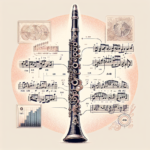Vibrato is an expressive technique that can greatly improve a clarinetist's performance. It brings warmth and depth to the sound, making music more captivating and rich. While it might seem challenging at first, mastering vibrato is achievable for any dedicated player. In this post, we'll explore various clarinet vibrato techniques that can boost your playing.
Understanding Clarinet Vibrato
Vibrato involves a slight variation in pitch and intensity that adds emotional depth to the sound. This modulation can be created through several techniques, each with its own unique characteristics. As you start this journey, remember that developing your personal vibrato style is just as valuable as mastering the basic techniques.
The Importance of Vibrato
Vibrato plays several roles in musical expression:
- Expressiveness: It helps players convey emotions, bringing music to life.
- Color and Texture: Different vibrato speeds and depths can alter the sound's color, adding texture to performances.
- Phrasing: Vibrato can shape musical phrases, highlighting certain notes and adding dynamics.
Basic Types of Vibrato Techniques
There are two main ways to produce vibrato on the clarinet: arm vibrato and throat vibrato. Each technique has its uses and can be effective in different situations.
| Vibrato Type | Description | Best Used For |
|---|---|---|
| Arm Vibrato | Involves moving the arm and hand slightly while maintaining finger position | Creating wider, more expressive vibrato |
| Throat Vibrato | Uses throat muscles to create pitch variations while blowing air | Producing warm, soft tones in lyrical passages |
1. Arm Vibrato
Arm vibrato involves moving the arm and hand slightly while keeping your finger position on the keys. Here's how to practice this technique:
- Relax Your Arm: Make sure your arm is relaxed, and your wrist is loose.
- Practice Movement: Move your arm slightly up and down while playing a sustained note. The movement should be subtle yet controlled.
- Timing: Focus on the timing of your movements, aiming for slight oscillations rather than big shifts.
This technique is often used to create a wider vibrato that can be very expressive.
2. Throat Vibrato
Throat vibrato focuses on the vocal aspect of playing, where you create vibrato through your throat muscles while blowing air. Here's how to develop this technique:
- Breath Control: Start with deep breathing exercises to strengthen your diaphragm.
- Connect to Your Throat: Use your throat muscles to create slight pitch variations. It can feel similar to a subtle yawn.
- Gradual Speed: Begin slowly and gradually increase the speed of your oscillations while maintaining control.
Throat vibrato can produce a warm, soft quality, excellent for lyrical passages.
Combining Techniques
As you improve your vibrato, try incorporating both techniques to enhance your expressiveness. Switching between arm and throat vibrato can help you adapt to various musical styles and genres, such as classical, jazz, or contemporary music.
Exercises for Developing Vibrato
Here are some exercises to support your vibrato practice:
- Sustained Notes: Play long, sustained notes while incorporating vibrato. Start slow; emphasize even oscillations.
- Scale Work: Integrate vibrato into scales, starting with simple fingerings and then advancing to more complex sequences.
- Playback Subtlety: Listen to recordings of clarinetists known for their vibrato, such as Benny Goodman and Artie Shaw. Try to emulate their vibrato techniques.
- Mirroring: Use a mirror while practicing to observe your posture and movements as you engage in vibrato techniques.
Adapting Vibrato to Musical Contexts
Knowing when and how to use vibrato is key to effective music performance. It's often used to express emotion, so consider the following:
- Slow Pieces: Use wider and slower vibrato for lyrical, emotive phrases.
- Faster Pieces: Use a tighter, faster vibrato for more lively pieces to complement the tempo and rhythm.
- Audience Engagement: Feel free to vary your vibrato technique to evoke emotional responses from your audience.
The Martin Freres Touch
At Martin Freres, we value the history and craftsmanship of the clarinet. Our instruments are made to support expressive techniques like vibrato, giving players a rich, warm sound. The quality of our clarinets enhances the vibrato effect, allowing for smooth transitions and easy playability during performances.
As you improve your clarinet vibrato, remember that practice, patience, and personal expression are key parts of your journey. Practice both types of vibrato techniques regularly, try out the suggested exercises, and let your musical passion grow.







